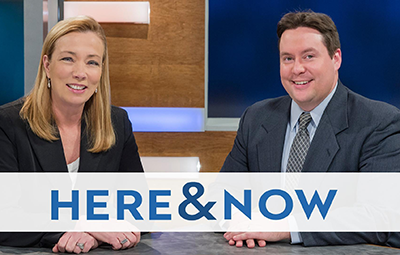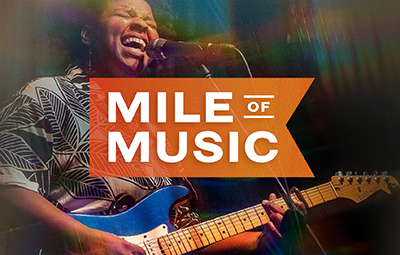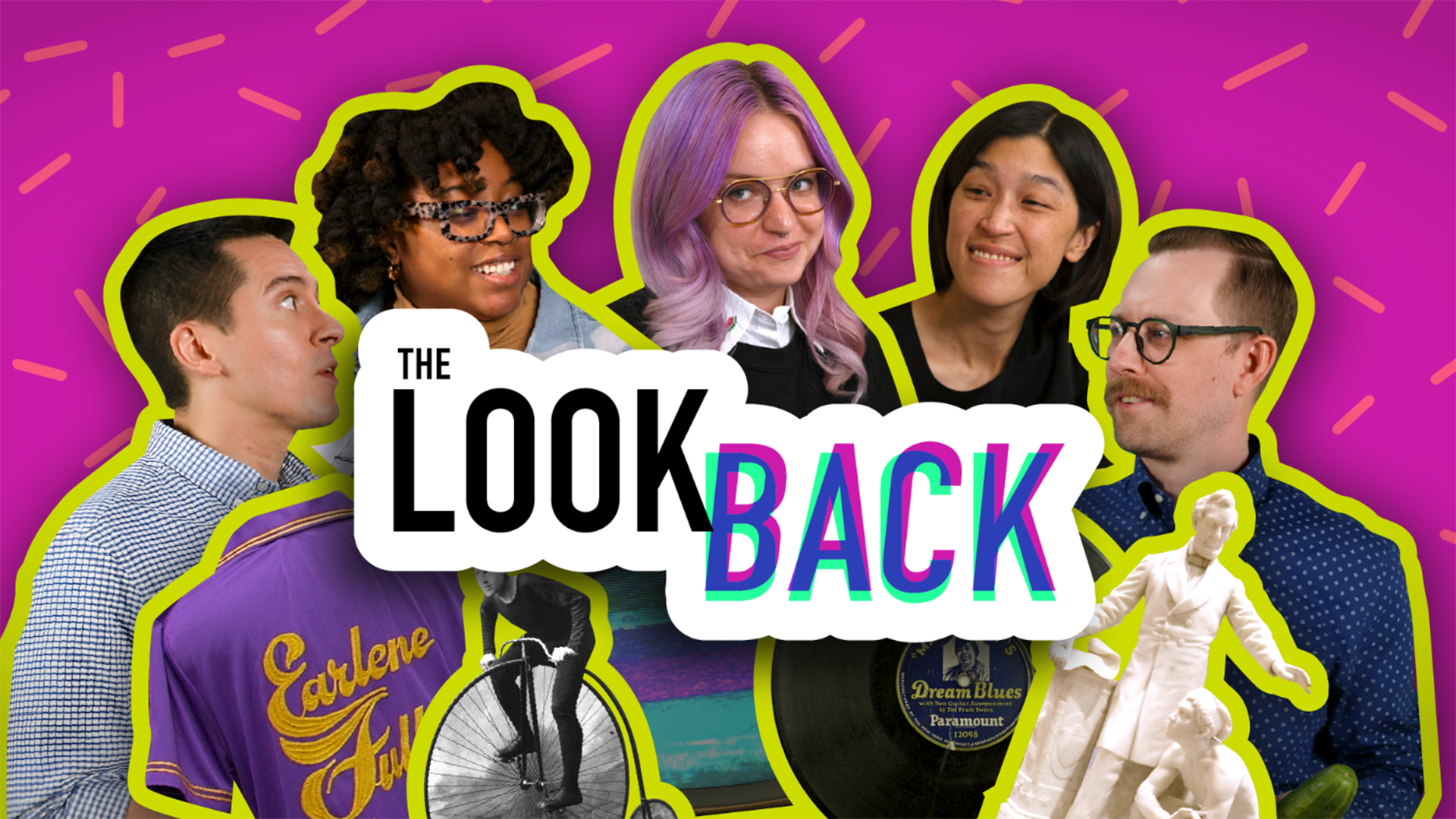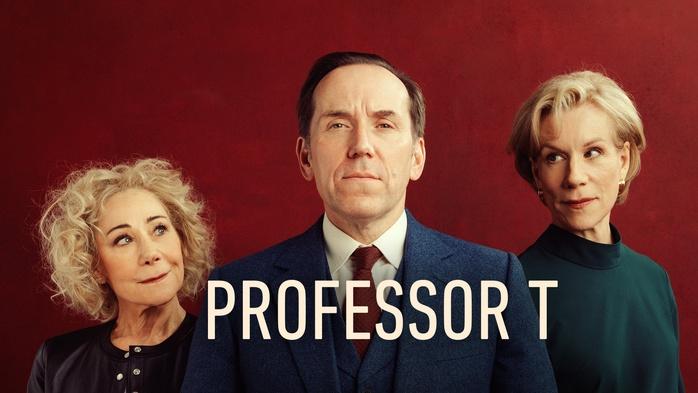[electronic music]
Sergio: Oh, Kacie, did you hear about the new shipwreck? They just found it off of Lake Michigan.
Kacie: No!
Sergio:Yeah, it was carrying a bunch of golden ducats.
Kacie: Ooh!
Sergio: Yeah!
Executive: [muffled scolding]
Sergio: Are you kidding me? We have to wear suits all the time now? Th-Th-That’s so unreasonable!
Kacie: They’re so…
Sergio: Boring.
Kacie: I was gonna say ugly, but that too.
Sergio: What’s next, Kacie? No colorful socks, no purple hair?
Kacie: But my hair grows this way. It does!
Sergio: Anyways, we have to figure something out.
Kacie: Well, what do you propose? You heard him. He barely let us get a word in. He said it was the new rule.
Sergio: Hmm. What if we talked to somebody who knows a little something
about protesting, about making your voice heard?
Kacie: Now, I like what you’re thinking. Let’s ditch these suits and go.
Sergio: All right, let’s go.
Kacie: Hi, Stu!
Stu Levitan: Oh, hi, Kacie!
Kacie: Good to see you. So I called you because we have a bunch of questions about protests on campus in Madison, but also in Wisconsin, and I knew you were the guy.
Stu: I’m happy to help.
Kacie: So why did you tell us to meet you here?
Stu: Well, because Bascom Hill is one of the ground zeros for all of the protest activity that happened during the 1960s.
Kacie: Can you give us a sense of what was going on in the 1960s?
Stu: In terms of protests, the first protests of the ’60s were civil rights protests. And they were very polite and orderly. There were people picketing. There was a movement in the South to stop the five and dime stores, the Woolworth’s and Kresge’s, that were discriminating against Black patrons and wouldn’t let them sit at the lunch counters. So there was a series of demonstrations, and the same month that that started in Tennessee, there were people in Madison
picketing the Woolworth’s on the Square, just marching around with pickets. And that kind of just gentle picketing continued for a couple of years,
and by the mid-1960s, you got a whole new generation
of protesters.
Kacie: The 1960s were a time of tremendous social change. Young people in particular played a huge role in pushing for change in the United States. Young people also participated in the civil rights movement, which fought for equal rights for all people, regardless of their race. They supported protests for women’s rights that worked to give women more opportunities for work and education. They also protested in support of gay rights and efforts to increase awareness around environmental issues. These protests mattered and led to important legislation like the Civil Rights Act. All of this to say that the 1960s are rightfully remembered as a decade where young people fought for change.
Sergio: So, you had these more polite protests that are happening through the early 1960s. What begins to shift in the middle of that decade?
Stu: The war. 1965 is when Vietnam supplants civil rights as <i>the</i> main issue. President Johnson starts bombing Vietnam in February 1965, and that creates a whole new generation of protest. And then you turn from polite protest to some level of disruption.
Sergio: The Vietnam War was a conflict from 1955 to 1975 between communist North Vietnam and non-communist South Vietnam. It was fought during the Cold War, an international clash between the United States and the Soviet Union. The U.S. joined the Vietnam War in an effort to stop communism from spreading in southeast Asia. The conflict, however, proved long, costly, and deadly. Many Americans questioned why their country was involved, especially as they watched the death and destruction caused by battles every night on their television. Antiwar protests grew in the 1960s, led by students, activists, and even veterans. The biggest protest was held in 1969, when hundreds of thousands of Americans gathered in Washington, D.C.
Kacie: After nearly 20 years of conflict, the war finally ended in 1975 with North Vietnam’s victory. Many soldiers died, and the U.S. faced deep divisions for years afterwards. The protests around the war changed America, showing how citizens could speak out against the role of the U.S. military abroad and influence how our government makes decisions.
Stu: The Vietnam protest era in Madison, on this campus, started on October 18, 1963 with 350 people holding pickets in a little polite rally in front of the Memorial Union. In October 1969, there were 15,000 people in the Field House.
Kacie: Wow.
Stu: 15,000 people. And then they all marched up State Street and had a candlelight service. They were holding candles, it was raining. They had candles under their umbrellas, and they all had the names of a Wisconsin serviceman who had died in the war. And the bell of Grace Episcopal Church tolled, and each time the bell tolled, they extinguished a candle.
Kacie: Wow.
Stu: 350 people to 15,000 in the space of six years. Every year that the war went on, more and more people went from either pro-war or “It’s not relevant to me,” to “I’m starting to get concerned,” to “Oh, I gotta march,” or “Oh, this is really serious.” I mean, every year, it just ticked up and up and up.
Kacie: Can you talk about what students were seeing and what they didn’t like about the Vietnam War?
Stu: Well, the first thing they didn’t like about the war was that if they were a young man, they could be drafted and sent to Vietnam.
Kacie: Military conscription is the practice of requiring United States citizens to serve in the military. It is informally called “the draft” because men were drafted into service. From 1940 to 1973, the draft was used during peacetime and during times of conflict to fill vacancies in the armed forces. However, not everyone was okay with this practice. When the United States entered World War II, some men became “conscientious objectors,” meaning they wouldn’t serve in the military. During the Vietnam War, resistance to the draft reached its peak. During this period, men who refused to be drafted were called “draft dodgers.” These men refused to sign up for conscription and some even left the country– actions which could result in steep fines or even jail.
Stu: They were afraid of being sent to Vietnam, they opposed the war on philosophical grounds, and they saw it every night on their television. From 1965, ’66, ’67 and on, you saw the Vietnam War live and in color in your living room. And it really radicalized a whole generation, and it frightened a whole generation. That’s what most of the people were protesting.
Sergio: Where have you brought me now?
Kacie: I brought you to the UW Archives.
Cat Phan: Hey, guys.
Sergio: Oh, Cat, what are you doing here?
Cat: I work here, Sergio.
Sergio: Oh, I didn’t know that.
Cat: Well, welcome to the University Archives. We collect, preserve, and make accessible materials about the university. So, Kacie said you were coming, so I pulled a bunch of stuff, and here’s the last poster you asked for.
Kacie: Thank you, I’ve been looking for this one.
Sergio: Cat, what are we looking at? Can you give us a little bit of a rundown on what we see?
Cat: Kacie asked for posters about the Vietnam-era protests, and I pulled a selection of items for you to look at.
Sergio: Now, when you say a selection, you’re saying there’s more than what you just have right here?
Cat: Oh, yes. This is just a tiny fraction of what we’ve collected.
Kacie: I really wanted us to come to the archives to see this poster specifically. Because we were talking with Stu about the draft and about all the anti-Vietnam sentiment, and I thought this poster was a really good example of the types of conversations that people were having, and how you can use a poster as a way to learn about the past. So at the top, it says, “Dump the Draft,” right, and it’s in the shape of an American flag, which you have to anticipate, you see this and it kind of draws you in. And there’s a bunch of questions, right? “Should we repeal it?” “Should it be a volunteer army?” “Should we do conscription?” “Is it a two-year extension?” You can see that people were having conversations about what to do with the draft, and maybe people disagreed about that, right?
Sergio: And the fact that you’re saying conversation, you’re saying there must be another perspective. And here, I’m thinking about another poster here that Cat’s brought us. This is probably one that a lot of people are familiar with. It’s Uncle Sam pointing at someone and saying, “I want you,” right? And so here you have what that is, in conversation with what it’s responding to.
Cat: What’s interesting for me to think about is students are posting posters up in high-traffic areas, and what if they put these posters next to each other? What would students think of a poster that said, “I want you to join the Army, this is a positive thing,” versus the conversation that is happening with the draft poster that Kacie talked about.
Sergio: And that’s what these posters are supposed to do. They draw people into the conversation to be a part of that discussion.
Kacie: Yeah, and then also us historians today, we can learn so much from just one little piece of paper.
Sergio: All right, a visit with Stu, a trip to the archives, I think we have all the tools we need.
Kacie: All right, let’s get to making these posters, and we’ll make our voices heard.
Sergio: Protests have a long history in the United States. Our country’s start can literally be traced back to an act of protest. For over two centuries, protests, whether through marches, speeches, or social media have helped shape the country by pushing for equality, justice, and change. They’re a crucial part of civic life in a democracy.
Kacie: Are there issues that are important to you? Talk to your friends and classmates and see if they care about those issues too. Together, you can all talk about how to bring more awareness to your cause. You might decide to make your own protest posters. Don’t be shy. Your voice matters! All you need is some big paper, some art supplies, and an issue that matters to you. What do you think?
Sergio: That’s not bad.
Kacie: But I’ve also heard them called skirmishes, protests, riot. Where do those kind of labels get put on, and how do those work?
Stu: Well, they get put on by people like me.
Kacie: By the historians.
Stu: By the historians, yeah. You have to trust that the historian is accurate in saying, “Okay, so here’s what happened.”
Search Episodes

Donate to sign up. Activate and sign in to Passport. It's that easy to help PBS Wisconsin serve your community through media that educates, inspires, and entertains.
Make your membership gift today
Only for new users: Activate Passport using your code or email address
Already a member?
Look up my account
Need some help? Go to FAQ or visit PBS Passport Help
Need help accessing PBS Wisconsin anywhere?

Online Access | Platform & Device Access | Cable or Satellite Access | Over-The-Air Access
Visit Access Guide
Need help accessing PBS Wisconsin anywhere?

Visit Our
Live TV Access Guide
Online AccessPlatform & Device Access
Cable or Satellite Access
Over-The-Air Access
Visit Access Guide
 Passport
Passport






Follow Us